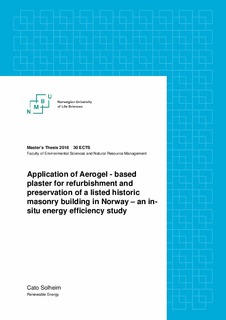Application of Aerogel-based plaster for refurbishment and preservation of a listed historic masonry building in Norway : an in-situ energy efficiency study
Master thesis
Submitted version
Permanent lenke
http://hdl.handle.net/11250/2572568Utgivelsesdato
2018Metadata
Vis full innførselSamlinger
- Master’s theses (MINA) [668]
Sammendrag
This thesis examines the energy efficiency effects of refurbishing historic masonry buildings in a Norwegian climate with the use of an aerogel-based plaster (FIXIT222) for cold side insulation. Additionally, it aims to find how well the manufacturer’s performance graph of FIXIT222 applies to brick buildings in a Norwegian climate.
The Norwegian government has proclaimed that it aims to make way for energy efficiency in the existing building mass as a means toward a “greener” future. In the capitol of Oslo, the existing building mass consists largely of late 1800’s masonry buildings. Because of the old age, these buildings are poorly insulated, which leads to significant heat loss, inadequate energy efficiency and often, unhealthy indoor climate. They need refurbishing.
Refurbishing of existing building regulates by the national Regulations on technical requirements for building works (TEK17). The net energy demand requirement for TEK17 is very difficult to achieve in such buildings without extensive insulation on the warm side of the envelope. This is bad for the building bricks, as the temperature outside the insulation drops and may lead to storage of moisture, which in turn will freeze and the bricks crackle. It also reduces the living area indoors (BRA).
The alternative is cold side insulation. However, most of these buildings have historic value and are listed in the Cultural heritage management office’s “yellow list”, meaning that any substantial changes to the façade or original structure is prohibited.
Fixit222 is a super insulating Aerogel-based plaster that can be sprayed on the building façades without substantially altering the architectural expression and thus, the historical value. The Cultural heritage management office has given Boligbygg Oslo KF permission to refurbish an 1890’s brick building in this way.
Analyses of the effect is found by field study data collection and model studies with the building energy simulation software SIMIEN.
The model studies show a total decrease in net energy demand by 65%. When pinpointing the effect of FIXIT222, it represents 34% of the total decrease in net energy demand. Temperature and relative humidity measured inside the wall remain well balanced throughout varying indoor and outdoor conditions.
In comparison with the measured energy consumption, the model estimates overshoot reality by 30%. This difference may be explained by the need to extrapolate the consumption data. Based on the results found, it can be concluded that the effect of FIXIT222 in Norwegian climate is of the same magnitude as the result of the pilot project “Mühle Sissach”. It can also be concluded that the manufacturer performance graph is directly applicable to 1980’s masonry buildings in Norwegian climate.
Beskrivelse
A combine in-situ and model study of the effects of refurbishing an old masonry building with an Aerogel plaster in Olso, Norway.

